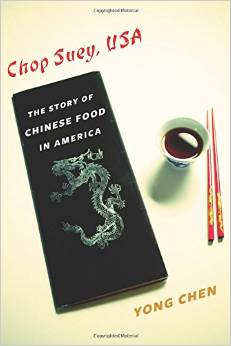 Reading Yong Chen’s new book Chop Suey, USA: The Story of Chinese Food in America is an education. In some ways, it seems more like an encyclopedia or a peak into the brain of a man who has read and retained an almost overwhelming number of books. Chen’s books is filled to the brim with details about the history of Chinese American food. Beginning with a brief history of the culinary realm in China, the books delves into the rise and development of Chinese restaurants, Chinese cookbooks, and the Chinese American population generally. He places credit for the proliferation of Chinese restaurants in the US not in Chinese foods’ innate tastiness, but rather to both Chinese immigrant entrepreneurship and trends within our nation’s development. Sound complicated?
Reading Yong Chen’s new book Chop Suey, USA: The Story of Chinese Food in America is an education. In some ways, it seems more like an encyclopedia or a peak into the brain of a man who has read and retained an almost overwhelming number of books. Chen’s books is filled to the brim with details about the history of Chinese American food. Beginning with a brief history of the culinary realm in China, the books delves into the rise and development of Chinese restaurants, Chinese cookbooks, and the Chinese American population generally. He places credit for the proliferation of Chinese restaurants in the US not in Chinese foods’ innate tastiness, but rather to both Chinese immigrant entrepreneurship and trends within our nation’s development. Sound complicated?
It is, a little bit. Chen’s book is not for someone looking for a nice airplane read about chop suey and egg foo young. Rather, this is a complex addition to the history of Chinese food in the United States. Chen hopes to answer the question: Why did Chinese food become so popular in America?
But in answering it, the book does not confine itself only to the history of Chinese restaurants, and also looks at this question from a national and global perspective — from the emergence of Chinese restaurants just as a developing middle class was looking for cheap options for eating out, to the first cookbooks to emerge in dynastic China. For anyone who wants to understand in depth where Chinese food fits into the large arc of American history, this one is a winner.
The author, Yong Chen, grew up in China and came to the US for his graduate studies and perhaps this is what allows him to take a thoroughly unromantic take on American history (of course his background also helps him to integrate Chinese sources on the long history of the culinary tradition in China). Understanding that the United States was an empire is crucial to his central argument. While I don’t disagree, the writing in these early chapters is more difficult to follow and grounded in political and philosophical theories, including the writings of Karl Marx and Alexis de Tocqueville. Other academics also make cameos, somewhat disrupting the narrative. However, as Chen moves towards the development and growth of Chinese restaurants in the early twentieth century, the pace picks up speed. Chen looks at the perspective of individual Chinese Americans for whom the food industry was part of their socioeconomic identity. He also shows how Chinese restaurants emerged alongside abundance, as the masses gained access to what had previously been a privilege only for the wealthy–eating food prepared by others.
“Chinese restaurants marched en masse to non-Chinese neighborhoods and communities…it signaled a profound transformation in lifestyle and the beginning of mass consumption in the realm of food.”
Looking at Chinese American food at its intersection with such national and global trends is Chen’s forte and offers a valuable addition to the academic field. However, for the casual reader with less knowledge of Chinese American history and American history, Chop Suey, USA could feel overwhelming. At certain moments, it feels like Chen is attempting to cram too much information into his writing, sometimes distracting from the main arc with his troves of evidence and quotes. At other junctures, it felt like a reader with no background on the topic would miss how the history of Chinese immigration, and their exclusion, critically affected the Chinese American population and the industries they entered.
Nevertheless, readers can learn much from Chen’s in-depth analysis and framing. He covers some fascinating topics: from why and how African Americans and Jews came to frequent Chinese restaurants, to similarities between the Chinese restaurant worker and the Chinese laundry worker. From a comparison and explanation of why Chinese food took off in the US while Filipino food did not, to a survey of Chinese American cookbooks, to the boggling question: is chop suey an American food, a Chinese food, or a Chinese American food? It’s a book to digest slowly.
I leave you with one of the most idiosyncratic features of Chop Suey, USA: the occasional inclusion of recipes. From moon cakes and fried rice to risotto and gumbo. Wondering why? You’ll just have to read the book.
- Excited
- Fascinated
- Amused
- Disgusted
- Sad
- Angry








